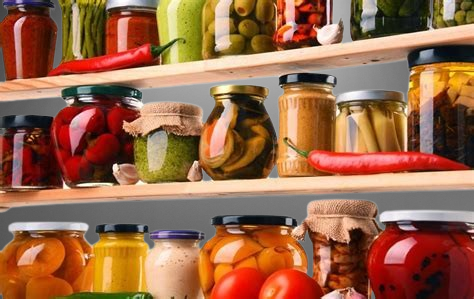Table of Contents
Effective food storage is essential to maintaining the safety, flavor, and nutritional value of the food we consume. Understanding the fundamental principles of food storage can help prevent spoilage and waste. One of the most critical elements of food preservation is temperature control. Different types of food require specific temperature settings to maintain their freshness. For instance, perishable items like dairy products, meats, and certain fruits and vegetables should generally be kept in the refrigerator at temperatures below 40°F (4°C). Conversely, frozen foods should be stored at a consistent 0°F (-18°C) to ensure longevity.
The methods of food storage can vary significantly and include refrigeration, freezing, drying, canning, and vacuum sealing. Each method serves a different purpose and may suit varying types of food. Refrigeration slows down the growth of bacteria, while freezing virtually halts it, allowing for longer storage times. Canning, on the other hand, involves sealing foods in jars, which provides a shelf-stable product without the need for refrigeration. Understanding these methods equips individuals with the knowledge needed to choose the most suitable option for their food items.
Another important aspect of food storage is the best-before date, which indicates the period during which the food is expected to maintain its best quality. It is crucial to understand the distinction between best-before dates, which relate to food quality, and use-by dates, which reflect safety. Proper adherence to these dates, coupled with appropriate storage techniques, can significantly reduce the risk of foodborne illnesses and ensure the food remains palatable.
Organizing Your Kitchen for Optimal Food Storage

Organizing your kitchen effectively is crucial for optimal food storage and can significantly enhance your culinary experience. Establishing designated areas for various food categories, such as grains, canned goods, and perishables, streamlines your cooking process and ensures that items are easy to locate. For example, keep dry ingredients like pasta and rice on shelves, while storing refrigerated items in a dedicated section of your refrigerator.
Utilizing clear containers not only provides visibility but also enhances the aesthetic appeal of your kitchen. Clear containers allow you to quickly identify the contents, which can help prevent the unnecessary purchase of duplicate items. Furthermore, these containers support portion control and maintain freshness, particularly for items such as flour or nuts, which are prone to spoilage. When using clear containers, consider choosing stackable options to maximize space in your kitchen cabinets.
Labeling is another essential aspect of food organization. Clearly marking containers with names and expiration dates boosts efficiency by ensuring that food items are easily identifiable. Labels assist in keeping track of what is available and signal when it’s time to use or discard certain products, minimizing food waste. You might opt for a label maker or simple adhesive tags—both are effective means of communicating relevant information about stored items.
storing foods,storing foods in freezer,storing,dry goods storage,storing food safely,storing food in mason jars,storing vegetables,foods to store,storing shredded cheese,long term storage foods,storing vegetables long term,foods for long-term storage,long lasting foods for survival,foods in covid 19,stockpile foods,best foods for long term food storage,dry goods,non-perishable foods,basic foods for emergency food storage,survival foodsCreating a clean, tidy kitchen environment is crucial for preventing cross-contamination, which can lead to foodborne illnesses. Regularly cleaning surfaces, utensils, and storage containers helps maintain a hygienic approach to food storage. Furthermore, ensure that raw meat is kept separately from other food types to minimize risks associated with bacteria. By organizing your kitchen with these principles in mind, you set the stage for efficient, safe, and enjoyable cooking experiences.
Common Mistakes to Avoid When Storing Food

Proper food storage is essential for maintaining the quality and safety of the items in your kitchen. However, many individuals make common mistakes that can lead to spoilage or waste. One prevalent error is over-stocking the refrigerator. When the fridge is too crowded, air circulation becomes compromised, preventing even cooling. This can lead to uneven temperatures, which may accelerate spoilage. To prevent this, ensure that your fridge is not packed beyond its capacity; allow enough space for air to circulate freely around your food.
Another frequent mistake is the improper use of wrapping materials. Many people rely on plastic wrap or aluminum foil without considering the specific needs of different foods. For example, certain fruits and vegetables need to breathe; wrapping them too tightly can trap moisture, leading to mold growth. Instead, consider using breathable bags or containers designed for produce. Similarly, meat should be wrapped properly to avoid exposure to air, which can lead to freezer burn. Always choose the right materials to extend the shelf life of your food items.
Additionally, a misunderstanding of the shelf life of various food items can result in unnecessary waste. It’s essential to differentiate between “best by” and “use by” dates, as the former indicates quality rather than safety. Many items can still be consumed after the “best by” date if they have been stored correctly. Regularly check your pantry and refrigerator for items nearing their expiration dates, and consume or freeze them before they go bad.
Finally, mixing certain foods can pose health risks or contribute to spoilage. For instance, storing apples next to potatoes can cause the potatoes to sprout prematurely due to the ethylene gas that apples emit. Be mindful of how you group your food items and store them separately when necessary to maintain their To buy storage equipment
Innovative Food Storage Solutions

In today’s fast-paced world, finding efficient ways to store food in the kitchen is essential for maintaining freshness and minimizing waste. Innovative food storage solutions have emerged, providing users with advanced tools and techniques to enhance their culinary experience. One effective option is the use of vacuum sealers. These devices remove air from storage bags, significantly prolonging the freshness of perishable items. By minimizing exposure to oxygen, vacuum sealing prevents freezer burn and helps preserve flavor and nutrients, making it an ideal choice for maintaining the quality of both meats and vegetables.
Moreover, technology has introduced food storage apps that assist individuals in tracking the freshness of their ingredients. These applications allow users to log expiration dates and send reminders when items need to be used, reducing the likelihood of spoilage. Some apps even suggest recipes based on the ingredients currently available, aiding in creative meal planning while maximizing shelf life. Couples with these digital solutions, eco-friendly storage options are becoming increasingly popular; using reusable glass containers or beeswax wraps reduces reliance on single-use plastics, offering an environmentally conscious alternative for food preservation.
In addition to utilizing specific tools, preserving seasonal ingredients can further enhance storage methods. Techniques such as canning, pickling, and dehydrating allow individuals to enjoy favorites year-round while maximizing the shelf life of seasonal produce. Embracing creative culinary techniques not only aids in keeping food fresh but also opens opportunities for new flavors and dishes. By adopting these innovative food storage solutions, individuals can create an organized kitchen space that reduces waste and promotes a sustainable food culture.





[…] separating vegetables by their storage conditions not only promotes better preservation but also aids in maintaining their texture and flavor. By being mindful of the […]